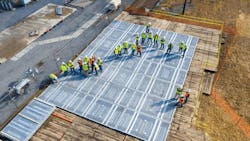Safety plans for transmission, distribution, and mobile substation projects are critical to keeping your teams safe. The inclusion of power lines introduces an additional layer of safety considerations, requiring a specialized approach to your safety plan.
Steps for Crafting a Comprehensive Plan
The initial step in creating a safety plan for power work zones involves a thorough understanding of its purpose. The objective is to identify potential safety hazards, communicate them to stakeholders, and establish proactive measures to prevent accidents.
To achieve this, it's crucial to understand the type of project or work that will be performed including:
- Project location
- Equipment to be used
- Project type
- Size of the project
The safety plan, once developed, must gain approval from project owners and stakeholders. Subsequently, it is distributed to all site visitors through orientations that include safety training to familiarize them with hazard avoidance protocols.
A construction safety plan is a dynamic document, requiring updates when the project scope changes, new safety issues arise, or accidents occur, necessitating the implementation of new protocols.
What to Include in Your Safety Plan
Each project possesses unique hazards, demanding customization based on scope and site conditions. Components to include in your safety plan comprise:
- Project details, including location, type, goals, and scope.
- Project timeline with start and end dates and key milestones.
- Potential hazards based on scope, geography, and site conditions.
- Site drawings indicating hazard locations and first aid stations.
- General and site-specific safety practices.
- Guidelines for personal protective equipment.
- Planned safety check schedules.
- Key project contact information.
- Company policies, accident investigation procedures, and communication plans.
Additional requirements may apply depending on the project, as outlined by the Occupational Safety and Health Administration (OSHA).
Safety Issues for Power Line Maintenance and Rebuilds
Power line projects introduce unique challenges, primarily due to electricity. Considerations for your safety plan should encompass:
- Location of overhead and buried power lines.
- Protocols for operating near power lines and related equipment.
- Safety guidelines for working at heights.
- Project-specific personal protective equipment (PPE), including suitable footwear and insulated gloves, sleeves, and helmets.
- Matting requirements for establishing an equipotential grounding zone.
Benefits of a Safety Plan
Apart from reducing the risk of injuries and fatalities, a construction safety plan offers benefits such as streamlined reporting, fewer project delays, and a reputation for prioritizing safety.
Safety Matters at YAK ACCESS
At YAK ACCESS, our commitment is to provide safe work environments that help you protect your greatest asset—your employees. Outdated grounding methods that have been used for decades pose a hazardous risk to ground crews. Using Equipotential zone (EPZ) grounding grates, your team can establish exceptional and instant EPZ work safety zones with this safe, simple, and sustainable method. Collaborating with your team, YAK ACCESS can help to properly identify and mitigate potential hazards when accessing power lines, and ensure safe access for all.
Safestep™ EPZ Grounding Grates are the most reliable option for EPZ safety. Get your copy of the YAK ACCESS SafeStep™ EPZ Solutions package which includes an EPZ Safety Checklist, EPZ Lab Testing Report, and Worker Protection Video today.


